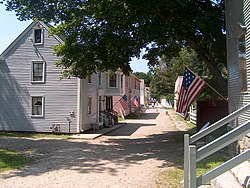United States historic place
| Strawbery Banke Historic District | |
| U.S. National Register of Historic Places | |
| U.S. Historic district | |
 Jefferson Street within the Strawbery Banke district Jefferson Street within the Strawbery Banke district | |
  | |
| Location | Portsmouth, NH Bounded by Court and Marcy Sts. and both sides of Hancock and Washington Sts. |
|---|---|
| Coordinates | 43°04′34″N 70°45′12″W / 43.07611°N 70.75333°W / 43.07611; -70.75333 |
| NRHP reference No. | 75000236 |
| Added to NRHP | June 20, 1975 |
Strawbery Banke is an outdoor history museum located in the South End historic district of Portsmouth, New Hampshire. It is the oldest neighborhood in New Hampshire to be settled by Europeans, and the earliest neighborhood remaining in the present-day city of Portsmouth. It features more than 37 restored buildings built between the 17th and 19th centuries in the Colonial, Georgian, and Federal style architectures. The buildings once clustered around a waterway known as Puddle Dock, which was filled in around 1900. Today the former waterway appears as a large open space.
History
The neighborhood's history goes back to 1630, when Captain Walter Neale chose the area to build a settlement, naming it after the wild berries growing along the Piscataqua River. In 1631, Humphrey Chadborn constructed the Great House, marking the first permanent English building in the neighborhood. Subsequent housing and an influx of English ships led the tidal inlet port at Strawbery Banke to be known for its mercantile success. As the settlement grew, the neighborhood now encompassed by the Strawbery Banke Museum was named Puddle Dock in reference to the merchants' wharves. Several wealthy Portsmouth merchants resided close to their wharves, further drawing esteem to the area. Strawbery Banke existed as a neighborhood for a little over three centuries from 1630 to the late 1950s. By the end of the 19th century, the Puddle Dock neighborhood had lost its former esteem. Much of the earlier industrial activity had since been abandoned and left in place. The neighborhood's buildings were saved from 1950s urban renewal by the efforts of a large group of historic preservationists. Strawbery Banke opened as a museum in 1965.
Education
Seventeen historic houses are open to the public as furnished historic interiors. Guests learn from staff interpreters the history and lifestyles of each house and how it reflects the social changes of its time period. In some houses, costumed roleplayers portray characters from time periods past. In others, historical interpreters educate visitors about the history. There are also five formal exhibits on archaeology, architecture, woodworking tools and skills, post-and-beam construction, and amusements and entertainment. Hearth cooking, weaving, basket weaving, and coopering demonstrations and tours are offered during a daily program season. Seasonal events are also held around major holidays.
Across the street from the museum are the riverside gardens and entertainments of Prescott Park.
Strawbery Banke was featured in Bob Vila's A&E Network production, Guide to Historic Homes of America.
Photo gallery
-
The Bailey House
-
 A cooper at work
A cooper at work
-
 Strawbery Banke entrance
Strawbery Banke entrance
-
 Lowd House
Lowd House
-
 Aldrich Garden
Aldrich Garden
-
 The Parlor, Thomas Bailey Aldrich Memorial
The Parlor, Thomas Bailey Aldrich Memorial
-
 The Reuben Shapley House at 420 Court Street
The Reuben Shapley House at 420 Court Street
See also
Notes
- The Reuben Shapley House was later occupied by Josiah Bartlett Jr., President of the New Hampshire State Senate, a U.S. Congressman, and the son of a signer of the Declaration of Independence. The house has been restored since this early photo was taken.
References
- "Exhibit Buildings". Strawbery Banke Museum. Retrieved September 1, 2010.
- Aldrich, Thomas Bailey (1893). An Old Town by the Sea. Cambridge, Massachusetts: H.O. Houghton & Co. LCCN 01008057.
- ^ Pope, Laura (May 21, 2013). Portsmouth Women: Madams & Matriarchs Who Shaped New Hampshire's Port City. Arcadia Publishing Inc. pp. 10–19. ISBN 9781626191006.
- Lawson, Russell M. (July 1, 2003). Portsmouth: An Old Town by the Sea. Arcadia Publishing. ISBN 978-0-7385-2427-6.
- Aldrich, Thomas Bailey (1893). An Old Town by the Sea. Cambridge, Massachusetts: H.O. Houghton & Co. LCCN 01008057.
- "Puddle Dock Timeline: Key dates in the history of Strawbery Banke Museum". SeacoastNH.com. 2004. Retrieved September 1, 2010.
- Bob Vila (1996). "Guide to Historic Homes of America". A&E Network.
Further reading
- Robinson, J. Dennis (2008) Strawbery Banke: A Seaport Museum 400 Years in the Making, ISBN 978-0-9603896-2-9
External links
Categories:- Houses on the National Register of Historic Places in New Hampshire
- Historic districts on the National Register of Historic Places in New Hampshire
- Historic house museums in New Hampshire
- Museums in Portsmouth, New Hampshire
- Open-air museums in New Hampshire
- Living museums in New Hampshire
- Historic districts in Rockingham County, New Hampshire
- Houses in Portsmouth, New Hampshire
- National Register of Historic Places in Portsmouth, New Hampshire
